Deputy Prime Minister of Canada
| Deputy Prime Minister of Canada | |
|---|---|
|
Incumbent None since February 6, 2006 | |
| Office of the Deputy Prime Minister | |
| Style | The Honourable |
| Member of |
|
| Appointer | Governor General of Canada |
| Term length | At Her Majesty's pleasure |
| Inaugural holder | Allan MacEachen |
| Formation | September 16, 1977 |
 |
| This article is part of a series on the politics and government of Canada |
|
Court system
|
|
Canadian federalism Monarchy in the Canadian provinces Executive Councils |
|
General
|
|
Canadian politics portal |
The Deputy Prime Minister of Canada (French: Vice-premier ministre du Canada) is an honorary position in the cabinet, conferred at the discretion of the prime minister. There is currently, as of 2015, no deputy prime minister.
The deputy prime minister should not be confused with the position of deputy minister to the prime minister, officially known as the Clerk of the Privy Council, which, like other deputy minister positions, is one of a civil servant and not a minister of the Crown.
History
The position of deputy prime minister was created by Pierre Trudeau in 1977,[1] largely to recognize the long years of service of Allan J. MacEachen.[1] Trudeau had previously given the title of Senior Minister to a member of his cabinet;[1] Paul Hellyer served as Senior Minister prior to his resignation from Trudeau's cabinet.[1]
Joe Clark's brief-lived government did not have a deputy prime minister.
Canada's most recent deputy prime minister was Anne McLellan, who in 2006 was also the first deputy prime minister to lose her seat in the House of Commons.
Current Prime Minister Stephen Harper has not formally designated a deputy prime minister, although he has given special status in the line of authority to members of his cabinet, similar to that which would be accorded to a deputy prime minister. Under an order-in-council issued by Governor General Michaëlle Jean on February 6, 2006—the day Harper was appointed prime minister—when "the prime minister is unable to perform the functions of his office" Lawrence Cannon, then Jim Prentice, then the balance of the cabinet by order of precedence, were "authorized to act for the prime minister."[2] This order has been followed by a number of orders updating the list. Previous prime ministers have had similar orders-in-council, under which the deputy prime minister, and then the balance of the cabinet in order of precedence, have been authorized to act for the prime minister.
Duties
The official duties of the deputy prime minister are to answer questions pertaining to overall government policy during Question Period, and to chair the cabinet in the absence of the prime minister. The office has no standing in law, and does not carry any formal duties or tasks; that is, it is without a portfolio, though the prime minister may negotiate or assign specific tasks in conjunction with the title. With the exception of Herb Gray, all deputy prime ministers have held a portfolio alongside this title.
One deputy prime minister, Sheila Copps, attracted controversy in 1993 after asserting that she was "in charge" of government business while the then Prime Minister, Jean Chrétien, was out of the country. After she left politics, she wrote that although the position of deputy prime minister is only ceremonial, "very often, the DPM's job was to protect the prime minister from the political damage that Question Period can inflict on a leader," further citing the experience of Erik Nielsen during the Sinclair Stevens scandal.[3]
Succession
Unlike the Vice-President of the United States, the deputy prime minister does not automatically assume the office of prime minister if the incumbent of the latter office dies or resigns. In the event of the sudden resignation or death of a prime minister, constitutional convention requires the governor general to consult the governing party and call on a member to form a government. No policy or convention precludes the deputy prime minister from being chosen as the new prime minister in such a scenario, but none assures it, either—the party caucus would be free to recommend any new leader of its choice to the governor general. Barring extraordinary circumstances, the governor general is expected to follow the wishes of the party, although officially he or she retains the authority to make the final decision. That being the case, no Prime Minister has died in office or resigned suddenly (except following his or her party's electoral defeat) since the 1890s, many decades before the office of Deputy Prime Minister was created.
In the provinces of Canada, the deputy premier also does not automatically succeed to the office of premier in the event of a sudden resignation or death. Unlike at the federal level, however, there have been instances where the governing party recommended that the deputy premier serve as premier on an interim basis until a permanent successor was chosen—most notably, Dan Miller ascended from the deputy premiership to the premiership of British Columbia in 1999, following the resignation of Glen Clark, and Kathy Dunderdale ascended from the deputy premiership to the premiership of Newfoundland and Labrador in 2010, following the resignation of Danny Williams.
Extended notice is usually given when a sitting prime minister does not plan to seek re-election. Leadership contests to determine the successor to a prime minister are usually held during the final days of the incumbent's term, and are traditionally a lengthy and competitive process. In almost all cases, the outgoing prime minister hands over power directly to their designated successor, without any interim prime minister. By contrast, during leadership contests for the official opposition party, the leader of the opposition has often (though not always) been occupied by an interim parliamentary leader. The opposition party's deputy leader (assuming that post is occupied) is often chosen for this role unless (s)he plans to run in the leadership election, in which case someone else would be chosen since it would be considered harmful to the election process if the interim leader was to be one of the candidates.
Legally speaking, any "interim" Prime Minister appointed by the Governor General would not merely be an "Acting Prime Minister," and would have the full powers and prerogatives of any other prime minister.
Succession chances
Chrétien is the only deputy prime minister who has gone on to become prime minister. However, no deputy prime minister has directly (or within one parliamentary term) ascended to the position of prime minister or party leader. By contrast, five Ministers of Finance have ascended to the office of Prime Minister; Sir Charles Tupper, R.B. Bennett, John Turner, Jean Chrétien, and Paul Martin. All but Chrétien (during his 1984 leadership bid) were considered the front-runners to succeed the outgoing prime minister or party leader. Chrétien was finance minister from 1977–79, deputy prime minister in the short-lived government of John Turner in 1984, was the front-runner when he mounted his successful 1990 leadership bid, and became prime minister after his party won a majority in the 1993 election.
Though Paul Martin did not hold the title of deputy prime minister during his tenure in cabinet, as finance minister, he was considered to be more influential than Copps while she was deputy prime minister. Martin's successor, John Manley, was the only finance minister to also hold the title of deputy prime minister, from 2002–2003. When Martin became prime minister, however, Deputy Prime Minister Anne McLellan generally had precedence over Finance Minister Ralph Goodale. McLellan turned out to be Canada's most recent deputy prime minister; the Liberals were defeated in 2006 and she lost her seat, opting to retire from politics afterwards.
The 2003 Liberal leadership convention saw the then former and then current deputy prime ministers, Sheila Copps and John Manley (also the finance minister), respectively, as candidates, but neither were successful in their bids, as Paul Martin had all but secured the leadership due to his massive delegate lead. Copps and Manley did not run for re-election to the House of Commons in 2004, and neither contested the Liberal leadership in 2006 that was triggered when Martin resigned.
Current prime ministerial line of succession
An order-in-council on 5 January 2015 updated the list of ministers to act for the Prime Minister if he is unable to perform the functions of his office.[4] The order gives the line of succession as:
- Joe Oliver
- Jason Kenney
- Tony Clement
- Diane Finley
- Rona Ambrose
- Peter Gordon MacKay
- Bernard Valcourt
- Robert Douglas Nicholson
- John Baird
- Peter Van Loan
- Gerry Ritz
- Christian Paradis
- James Moore
- Denis Lebel
- Leona Aglukkaq
- Lisa Raitt
- Gail Shea
- Julian Fantino
- Steven Blaney
- Edward Fast
- Kerry-Lynne D. Findlay
- Shelly Glover
- Chris Alexander
- Khristinn Kellie Leitch
- Greg Rickford
- Erin O'Toole
- Maxime Bernier
- Lynne Yelich
- Gary Goodyear
- Rob Moore
- John Duncan
- Tim Uppal
- Alice Wong
- Bal Gosal
- Kevin Sorenson
- Pierre Poilievre
- Candice Bergen
- Michelle Rempel
- Ed Holder
Deputy Prime Ministers
Key:
| No. | Portrait | Name | Term of office | Political party | Ministry | |
|---|---|---|---|---|---|---|
| 1 | 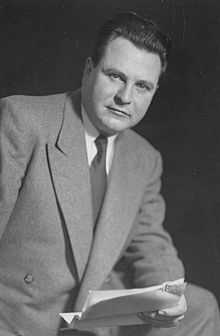 |
Allan MacEachen | September 16, 1977 | June 4, 1979 | Liberal | 20 (Trudeau) |
| – |  |
VACANT | June 4, 1979 | March 3, 1980 | – | 21 (Clark) |
| (1) |  |
Allan MacEachen | March 3, 1980 | June 30, 1984 | Liberal | 22 (Trudeau) |
| 2 |  |
Jean Chrétien | June 30, 1984 | September 17, 1984 | Liberal | 23 (Turner) |
| 3 |  |
Erik Nielsen | September 17, 1984 | June 30, 1986 | Progressive Conservative | 24 (Mulroney) |
| 4 |  |
Don Mazankowski | June 30, 1986 | June 25, 1993 | Progressive Conservative | |
| 5 | 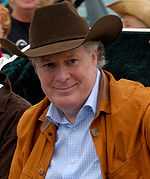 |
Jean Charest | June 25, 1993 | November 4, 1993 | Progressive Conservative | 25 (Campbell) |
| 6 |  |
Sheila Copps | November 4, 1993 | April 30, 1996 | Liberal | 26 (Chrétien) |
| – |  |
VACANT[NB 1] | April 30, 1996 | June 19, 1996 | – | |
| (6) |  |
Sheila Copps | June 19, 1996 | June 11, 1997 | Liberal | |
| 7 | 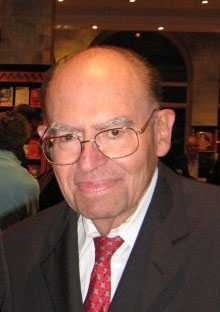 |
Herb Gray | June 11, 1997 | January 15, 2002 | Liberal | |
| 8 | 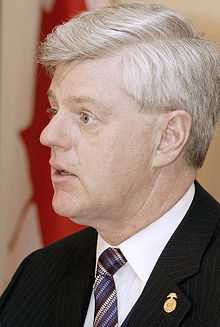 |
John Manley | January 15, 2002 | December 12, 2003 | Liberal | |
| 9 | |
Anne McLellan | December 12, 2003 | February 6, 2006 | Liberal | 27 (Martin) |
| – |  |
VACANT[NB 2] | February 6, 2006 | Present | – | 28 (Harper) |
Acting Prime Minister
Prior to the creation of the deputy prime minister's position, a prime minister would routinely appoint a member of the cabinet to temporarily serve as acting prime minister when the prime minister was scheduled to be away from the regular duties of his job for a period of time, such as being out of the country on a working visit or a vacation. An acting prime minister was essentially a caretaker, whose role was to oversee the routine day-to-day functioning of the government during the prime minister's absence; for example, in his capacity as acting prime minister, Mitchell Sharp ordered a precautionary one-day shutdown of government offices in Ottawa on August 20, 1970, as the storm which had spawned the Sudbury, Ontario tornado of that morning headed toward Ottawa.[5] Despite this, the acting prime minister did not have the authority to implement their own legislative or political agenda separately from that of the actual prime minister, nor was an acting prime minister formally or informally considered to have actually served as prime minister.
Due to the routine and relatively minor nature of the appointment, few to no research sources exist to provide a complete list of everyone who was ever given the duty. However, John Diefenbaker's appointment of Ellen Fairclough as acting prime minister on February 19 and 20, 1958 is historically noteworthy as Fairclough was the first woman ever given the appointment.
| Portrait | Name | Term of office | Political party | Ministry | ||
|---|---|---|---|---|---|---|
 |
Ellen Fairclough | February 19, 1958 | February 20, 1958 | Progressive Conservative | 18 (Diefenbaker) | |
Senior Minister
Prior to the creation of this position, the position of "Senior Minister" was a ceremonial position used in a similar manner, heading the order of precedence.[1] Upon the absence of the Prime Minister, the Senior Minister would become the Acting Prime Minister.[6]
| No. | Portrait | Name | Term of office | Political party | Ministry | |
|---|---|---|---|---|---|---|
| 1 | 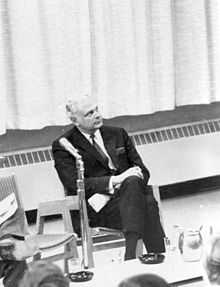 |
Paul Hellyer | April 30, 1968[6] | April 23, 1969[7] | Liberal | 20 (Trudeau) |
Notes
- ↑ The office was briefly vacant in 1996 when Copps, after being challenged on her 1993 campaign promise to resign if the government did not repeal the GST, resigned from Parliament and recontested her seat in a byelection. Chrétien did not name a replacement during Copps' absence from Parliament. After winning the byelection and returning to Parliament, Copps was reappointed to the position.
- ↑ Harper did not formally name a deputy prime minister, although in practice Lawrence Cannon (Member of Parliament for the district of Pontiac, Quebec) was named second below Harper in the order of precedence. Following Cannon's defeat in the 2011 election, Leader of the Government in the Senate Marjory LeBreton was named the first minister to act for Harper in his absence.
References
- ↑ 1.0 1.1 1.2 1.3 1.4 Ottawa Citizen, "A Heartbeat From The Top", Charles Lynch, 10 November 1982, pp.3
- ↑ PC 2006-1422, available at http://www.pco-bcp.gc.ca/oic-ddc.asp?viewattach=15421
- ↑
- ↑ PC 2015-0005, available at http://www.pco-bcp.gc.ca/oic-ddc.asp?viewattach=30329
- ↑ "Ottawa concerned". The Globe and Mail, August 21, 1970. p. 8.
- ↑ 6.0 6.1 The Gazette (Montreal), "Hellyer Appointed No.2 Man To Rule In Trudeau's Absence", 1 May 1968, p.3
- ↑ Reading Eagle, "Hellyer Quits Cabinet Job", AP, 24 April 1969, pg.47
External links
| ||||||